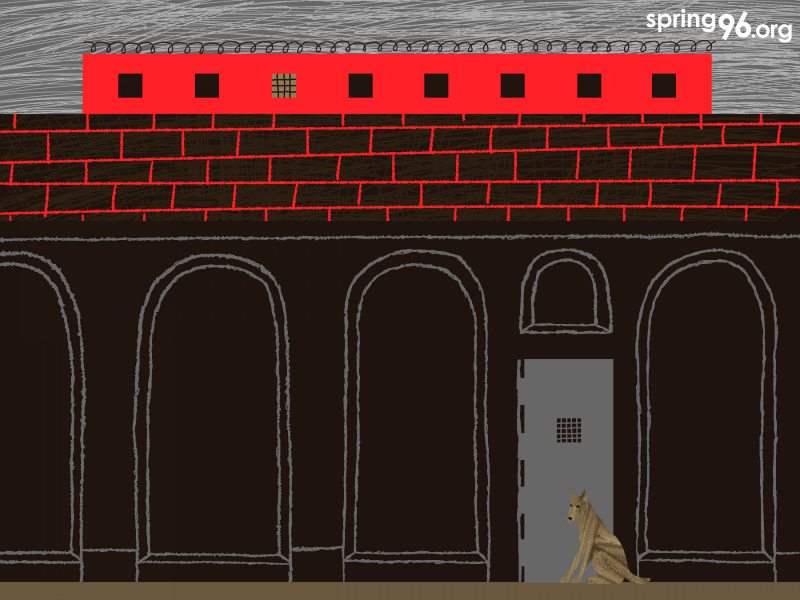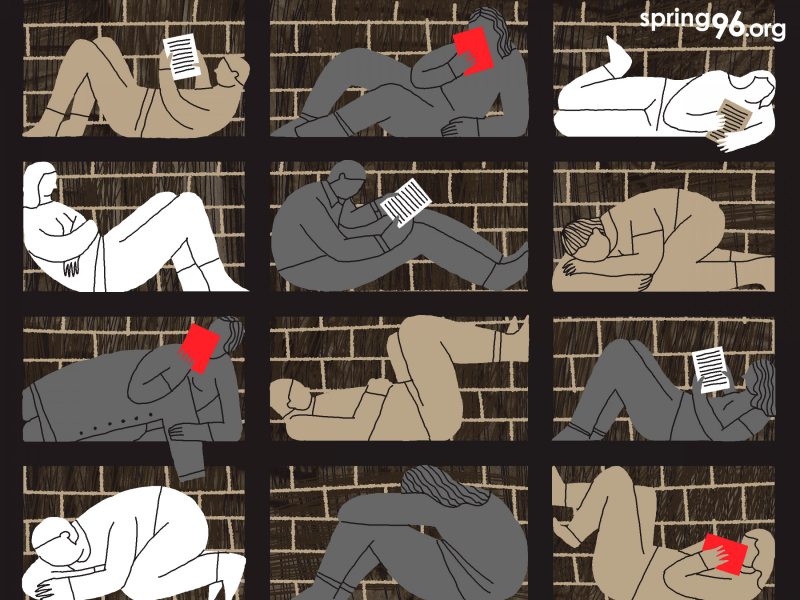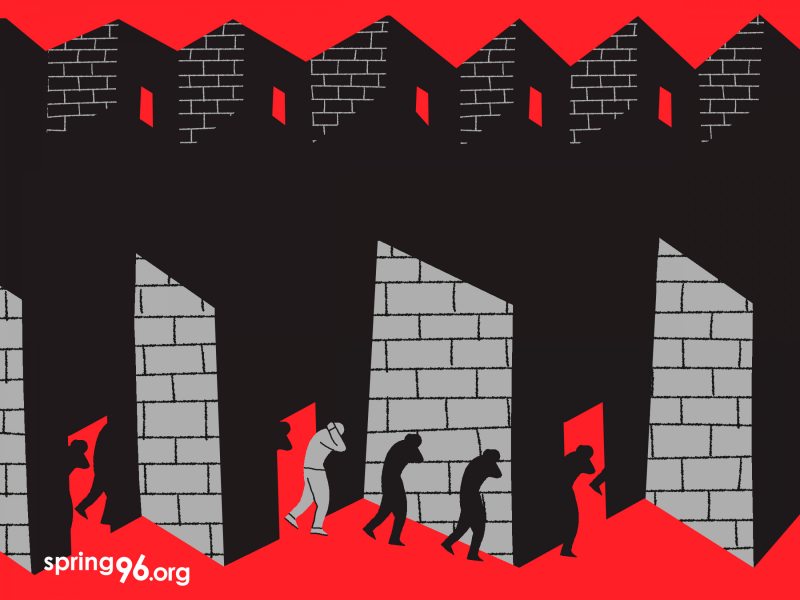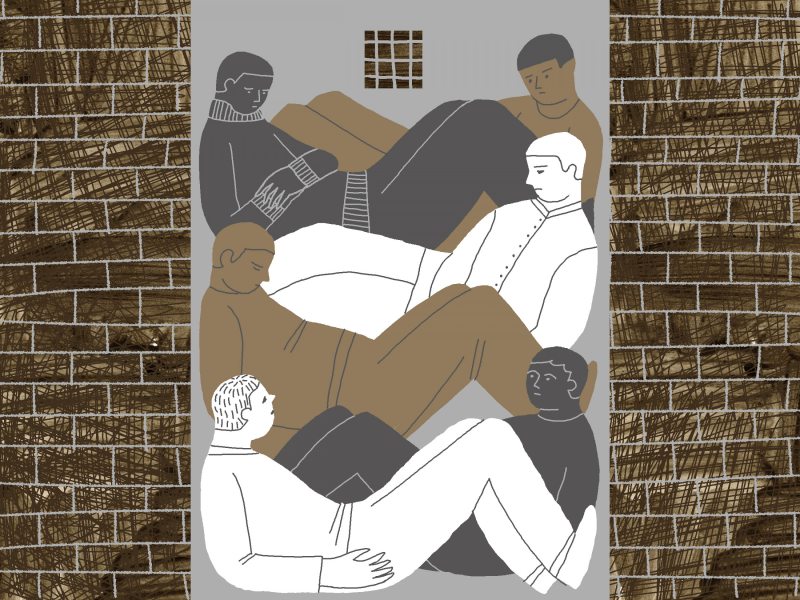“Gas sprayed into ventilation reached us”: Akrescina facilities detention conditions throughout 2022 in detainees own words
In August 2020, after detainees were released from the Akrescina detention center, the world saw mass signs of torture and beating. 28 months later, the situation of human rights in Belarus is still getting worse and more complicated. The repression is not over, despite the fact that we learn less and less about the detainees. The Belarusian authorities are doing everything possible to hide the real picture of repression from the world. They recognize independent media as ‘extremist formations’, bring people to criminal responsibility for publicizing violations of human rights, and enjail people who provide assistance to the victims. However, the solidarity of Belarusians is much stronger than the actions of the law enforcers. Viasna has prepared a month-by-month chronicle of arrests and detention conditions in the Akrescina detention center to show the scale of repression and how the methods of pressure on Belarusians used by the law enforcers and authorities have (not) changed throughout 2022.
 Akrescina Detention Center. Illustration by Volha Prankevich
Akrescina Detention Center. Illustration by Volha Prankevich
Detention conditions at Akrescina as torture
Throughout these 28 months, they detain people in inhumane conditions providing them with no hygiene products or a change of clothes. The authorities regularly ‘carousel’ the detainees: they do not release them after the first arrest, but return them to the detention center according to new reports for another detention term. The detainees who are kept in custody for three months can only breathe in the fresh air when they are taken to the police department to draw up a new report.
Those waiting for their criminal charge in the Temporary Detention Center are put in the notorious punishment cell. They are forced to sleep there on the floor in the cold. Without beds, without fresh air, without showers and warm clothes, and not always with food.
The ‘control’ cells are constantly overcrowded, so people have to sleep on the floor, under the beds, and on the benches. They are not given bed linen, not allowed to take a shower or go for a walk. Homeless people are put in these cells as additional pressure. The light is on day and night. The guards are monitoring every action of the detainees in the cells through the peepholes and video surveillance. There is no warm water, and the tap water is unsuitable for drinking. The detainees arrested at home are not allowed to take even hygiene products, so they come up with new means of hygiene, such as brushing their teeth with the things they have in the cell. Parcels are not handed to the detainees. Medical aid is not provided, despite the fact that many people arrive in Akrescina detention center beaten badly. The only source of information is their new cellmates who are arriving daily. Human rights defenders qualify these conditions as torture.
Testimonies of Akrescina detainees in 2022
December—at least 260 detainees
“My friend was released after ‘only’ seven [days of administrative arrest]. With pneumonia, barely alive. But she was lucky: women with a fever of 40°C were kept there, given just an aspirin pill as a medicine.
She was detained with 17 other ‘political’ detainees in a two-bed cell. Without heating, without warm clothes (they refused to accept the clothes as a parcel), but with flocks of bed bugs and cockroaches instead. She slept on the floor, because it hurt to sleep on the iron beds without mattresses and it felt as if she was ‘crucified’.
They put a homeless woman in their cell who never used the toilet to pee and all her clothes were soaked with urine for many days.”
November—at least 487 detainees
“At night, I slept under the table, because we simply had no room there. There could be up to 10 of us [women] in a two-bed cell of the Temporary Detention Center. The toilet was partially covered so that video cameras did not reach it. It was very cold, so we huddled together to keep warm. When non-political detainees came to us, they gave us jackets to keep us warm.
In the Offender Isolation Center, screams immediately started. I was warned that it would be hot and stuffy in the cell, but I didn’t think it would be that hot. It felt as if I came into a steam room in a bathhouse. You enter it, and a wave of sweat and heat hits you. The temperature there is somewhat around +36-40°C. The cell is not vented at all, the ventilation is never turned on, the ‘feeder’ [door window] is never opened. In the Temporary Detention Center we could breathe at least a little, but we couldn’t do it there. We asked to open at least the ‘feeder’ [door window] for us. There was a day when I mentally said goodbye to all my relatives, because I thought I was going to die. There were 18 of us in the cell, and we started fainting due to the lack of air. Condensed water was running down the walls. Then an employee came in to take away the garbage and saw it all, and after that they turned on the hood.
We just had no physical space in the cell. We slept wherever we could: under the bunks, near the toilet. We all wore just bras and slept in them because it was very hot. I was bitten by bed bugs and suffered from allergies. Besides, there were silverfish there. The girls who slept on the bunks were bruised as the iron bars would dig into their skin. Therefore, sleeping on the floor was considered the best option.
Many people are beaten during the arrest. There were people there who had been beaten with a frying pan, and I saw the marks and bruises on them.
You don’t have any personal belongings with you. They gave me nothing explaining that “That was the instruction regarding you”. When they brought me in, they immediately took away my jacket and did an in-depth examination, with squats.
We were not given mattresses. It was a little better in the Temporary Detention Center, because there were wooden bunks there, while in the Offender Isolation Center there were metal bunks. We were forbidden to lie on them during the day.
In the Offender Isolation Center we were woken up twice a night for searches—we had to get up and name ourselves. Once an inspection came at night, and they woke us up three times that night. Some chief inspector asked where ‘the controlled’ were placed (that's what they call those detained for political reasons in the Akrescina detention center). They showed him several cells and I heard him say, “Scum”.
October—at least 317 detainees
“There were a couple of criminals in the cell with us, but they were kept in check, even swearing was not allowed. They willingly contacted us and obeyed the common rules.
Of course, there is neither bed linen, nor walks. The stuffy air makes everyone cough, and our eyes are covered with pus. And of course there are lice there.
I feel so sorry for the young guys, because they are beaten very badly in GUBAZiK [the Main Directorate for Combating Organized Crime and Corruption]. One was beaten so badly that he could only lie on his stomach. We put him under the bars, where there was a little cold air draft so he could sleep.
It is psychologically easier for those who remember the Soviet Union: unlike the youth, we are not surprised that ‘people can be treated like this’, we neither expect anything, nor hope for anything, nor believe in anything. You got jailed? Well, keep calm and don’t make the boss angry, for it will make it worse for you.”
September—at least 413 detainees

- A cell in the Akrescina detention center. Illustration by Volha Prankevich
“Mikhail told us how bad it is in the ‘political’ cells, including women’s cell #15. There is little space and many people there; the lights are on at night; there is a roll call at 2 a.m. and 4 a.m.; the detainees are ill-treated; sometimes there is no hot water and the sinks are broken; the most unkempt people are placed there purposefully.
My acquaintance with the new detention center began from the promenade spot around 6 p.m. I got into the cell 10 minutes before the lights-out time. Before that, I was made to completely undress and do squats, and my clothes were searched. The employee asked me, “Why are you here?” and she immediately understood that I was a ‘controlled white-red-white’ one. At the very threshold of cell #9, I realized that I was lucky—that was a so-called ‘working cell’, from which women went to work at the city landfill, which meant that there was a chance to get dressed warmer in a while and not to expect night roll calls. I was well received, although I was the 15th in the four-bed cell. There were no mattresses there since the previous day. I was offered to sleep on the table—I poured warm water into a 1.5-liter bottle which I had with me and tried to sleep hugging it.
There were a lot of cockroaches and bed bugs in the cell, and often newcomers had lice. The first week, there were 19 women in the cell for four. Later some of them were transferred to the detention center in Mahiliou. On average, there were always 7-8 people in the cell. Some of them caused a lot of inconvenience.
Previously volunteers could hand over toothbrushes and toilet paper, but now nothing is allowed. They conduct searches and if they find toothbrushes and soap, they take them away,” a man says. “They don’t turn off the lights there, they wake you up every two hours. You sleep on the floor, like in Tetris: someone lies under the bed, someone is near the sink. You can’t stretch your legs because another person is already there. Once, when all 18 of us somehow managed to settle down, the door opened and two more people came in—they couldn’t even step on the floor, because there were people everywhere. Many were beaten, with broken ribs, with distorted faces. Some could not even breathe properly, because everything hurt. One man was put face down on the asphalt and dragged like that when arrested. Another one was taken away from home just in his slippers and underwear. He managed to grab only his wife’s jacket—and he slept like that on the floor for 15 days.
...I was transferred to a one-person concrete cell, one and a half meters wide and three meters long. There were seven people inside. Everyone was coughing and sneezing, some had a fever, others had a headache. No medicines were given to us. We slept on the floor. Besides, we were not allowed to sit down during the day. If someone sat down, they would immediately notice that and make us stand until the lights-out time.”
August—at least 387 detainees
"On Akrescina, there were 18 people in a four-bed cell. Sometimes that number reached 20. We managed to settle down for the night somehow, but the light was on constantly, the searches repeated... It was very stuffy in the cell. During the day it felt unbearable, but at night it was easier. We had a window in our cell that opened by one centimeter. To open it, we disassembled the broom and pushed the window with a straw. The straw would not last long, so we periodically ran out of a broom.
Dew to my life experience, physical torture had little effect on me. I had a hard time on Akrescina. I am an open person. Sitting for almost a month in a cell, which is two meters wide and four meters long, with the only view of the street, when a straw opens the window by one centimeter and you can see the same building, is difficult and it breaks you. If I had been in prison for another two months, I would have felt sick.”
July—at least 156 detainees
“When I got to the cell, I started washing myself. They started helping me. My right hand was swollen. It turned out that one of my cellmates was supposedly a plastic surgeon. He examined my hand moving my little finger up and down. My finger looked as if it had two separate movable bones in it. I had a fracture. The next day, I approached the nurse, showed her my hand through the door window, and said that I must have a fracture. She looked at it and said, “Yes, it may be a fracture,” and left. We called her “Doctor Death”. The next day I asked her again, “Are we going to do anything about the fracture?” She looked at me like I’m a moron and said, I don’t give a f*uck about you. I won’t do anything. The most I can do is give you painkillers.” The fracture has now grown together, not perfectly but that’s ok. So the medical care there is a nightmare.”
June—at least 200 detainees
“The conditions change every month. Compared to a year ago, the conditions are sometimes better, sometimes worse. Of course, the cells are classically overcrowded, neither linen or mattresses provided, nor walks, showers, parcels and hygiene products. There were 7 to 14 of us in notorious [two-bed] cell #15. As for the guys’ cells, I heard that there were 12 in one of them and 19 in another one. Besides, there were homeless people there with various insects. There were lice, cockroaches, silverfish, and bed bugs in the cells.
People are suffering from colds and sore throats en masse. Outerwear is taken away at the entrance. The lights are on at night, the roll calls are at 2 and 4 in the morning. It's impossible to get quality medical care. For example, there was a case when Ala Illinichna was brought to us (she was brought to us three times during my 30 days of arrest) and she got sick. We started knocking on the door and asking for help until she lost consciousness—the doctor did not come. During the day, no medicine is given, because “everything was given in the morning”—the fact that one can feel bad during the day is simply ignored.
It’s terribly cold in the Temporary Detention Center, where those under criminal charges are detained. Even in this hot weather, it is very cold there. Besides, bed bugs are very disturbing. The girls I met conveyed through the newcomers that they were catching colds in that overcrowded two-bed cell. The mood there is more depressing because, unfortunately, most of these people will go to the remand prison. The detainees were not beaten in the Offender Isolation Center, at least the girls. Everyone with whom I communicated, including myself, was beaten either at the district police station (RUUS) or at the Main Directorate for Combating Organized Crime and Corruption (GUBAZiK).
May—at least 263 detainees
“My first cell was in the Temporary Detention Center—cell #1. There are wooden shelves there, a dirty floor, a bench and a table, a bedside table, and a constantly dripping faucet. There were four of us in a two-bed cell. We had all spent the night at the district police station (RUUS), waiting for the trial, very sleepy, but no one would let us sleep—they kept knocking on the door and ordered us not to lie down or sleep.
It was good that there was water there—you could drink, and there was hot water and a bottle there—you could wash yourself. As for hygiene products, it depended on one’s luck. Some managed to take hygiene products with them, and some failed. I was not allowed to take a toothbrush, toothpaste, shampoo, etc. from home because the person who stayed with me during the search strictly controlled me when I was dressing. The only thing he allowed me to take with me was two packs of sanitary pads. I proudly went through all the inspections with these two packs, because you had to take everything valuable with you during the search, otherwise it would be seized. All of this, of course, is humiliating. For a month, I brushed my teeth with cotton wool and crushed activated charcoal, which we got from the doctors. Later, they stopped giving us cotton wool, which was given instead of pads. Instead, they began to give pads, as it should be. However, they gave one pad per day—not so hot.
In the ‘political’ cells in the Offender Isolation Center and Temporary Detention Center, detainees are still not allowed to sleep: the lights are never off and the roll calls are at 2 and 4 in the morning. This is sleep torture. The most brutal thing is that there are a lot of people in the cell. They do it consciously—they purposefully stuff the cells with people. It was dirtier in the Temporary Detention Center, because there is always a flow of detainees there, so no one particularly takes care of the cell there.
For some reason, the girls in the Temporary Detention Center especially liked to sleep on the bunks, even though bed bugs lived there, so they were always bitten. I didn’t want to sleep with insects, so I washed a part of the floor and slept on it. Then two more ‘carousel girls’ joined me (the girls who were re-arrested for a second term).

- Akrescina Detention Center. Illustration by Volha Prankevich
“I was first placed in notorious ‘political’ cell #15. It is a two-bed cell with a bunk bed with metal bars and without mattresses. There were up to 18 of us there—including five homeless women smelling terribly. There was no air to breathe in that small space. On top, as it turned out later, one of the homeless women had lice, so I left that cell being infected with lice.
In cell #15, we slept as if playing Tetris. Once, when there were 17 of us there, we somehow found a way to fit in about 9 square meters, but when the 18th girl was brought in, we realized that there was just physically no space for her. We slept on the floor, on the table, on and under the bench. A kind of a human Tetris. I climbed on the table and looked from above—and that’s how we freed a patch of the floor near the bedside table. As a result, the 18th person slept sitting up.
We peed sitting down is an innovation, it helped to make the toilet cleaner and less stinky. There was one guy there who accidentally got to the ‘political’ cell, and he was shocked. Another one, having moved literally from the neighboring cell, was amazed at us having hot water as they had only cold water in their cell.
They come for the morning inspections with a bucket of chlorine [water solution]. If they don’t like anything, they may pour this bucket on the cell floor.”
April—at least 317 detainees
“There were people there with completely blue [bruised] legs. This was the most common thing. But I was beaten on the head, so there were bruises under my eyes too. I have very bad eyesight, but when I was placed in the Offender Isolation Center, one of the employees refused to give me my glasses, saying that within those 15 days I would start seeing.
There was an eighteen-year-old boy in the cell who had been tortured with an electric shocker—he had numerous burns. Moreover, he was detained for paying for some online game with cryptocurrency, but he was accused of financing the protests. He was 16 years old at the time of those payments.
I already encountered that nurse in the summer of 2021, when I was detained without explanation at work and [sentenced to administrative arrest] allegedly for disobeying an officer. Perhaps that was the nurse who asked the law enforcers, “Boys, why are there so few broken heads?” after August 9, 2020. She refused to provide medical care to those detained for political reasons. If she was approached, she would ask for the article number, and if it was a ‘political’ article, she would simply turn her back and walk away. During the inspections that she attended, she would always mock us. When we asked for a doctor, she said that we will do without it.”
March—at least 445 detainees
“They did not pour chlorine [water solution in our cell], but the gas sprayed into the ventilation reached us. We coughed profusely, as did our whole floor.
The employees shouted very loudly at night and did it purposefully. They drank, clinked glasses, sang, and watched videos. We heard the rock ballad “Fall asleep, fall asleep in my arms” all night just behind the door. And they really liked to open the door and just look at us. They could also enter after the lights-out time.
...The air temperature was around 30°C, condensed water was running down the walls. The windows and the ‘feeder’ [door window] were closed. Throughout the day we were given only two portions of food for 16 people.
…Then I was transferred to an eight-bed cell. There were about 40 people there. We slept on the floor, on the benches, on the table, on and under the bunks. We spread our clothes to sleep on them. We addressed each other by our first names, for it was impossible to remember all the last names. Homeless people were put in all the cells. Once we were taken out for a morning inspection and a bucket of chlorine [water solution] was poured into our cell.
...According to those who were awake, the staff randomly selected several cells, then opened the door and ordered everyone to lie face down on the floor. After that, two employees walked over people, stomping on their backs. They beat one boy in the kidneys with their hands. A third employee stood at the entrance and filmed with a smartphone what was happening. After that, they went to the next cell. People were beaten there for a longer time, but it seems no one was seriously injured.
Several prisoners from other cells were severely beaten. As far as I understood, those were the ones who complained about the detention conditions.
The conflict with Yauhen Urubleuski broke out over the fact that we asked for toilet paper and to open the ‘feeder’ [door window]. In response, we heard, “You got what you fought for,” and swearing. A conflict began between us and him. As a result, I managed to pull one woman away, because I understood who he was. Urubleuski took another woman out into the corridor and hit her head against the wall.”
February—at least 1,204 detainees

- Punishment Cell in Akrescina Detention Center. Illustration by Volha Prankevich
“The cells were always overcrowded. The maximum was 40 people in a four-bed cell (we spent three days in that way). The minimum was 27 people in a six-bed cell. I changed about seven cells in total. The number of [administrative arrest] days varied from 12 to 15. The conditions were also bad. There was a guy with Covid among us who infected everyone (he warned that he was sick when he was arrested). We had indigestion from time to time. The heat was terrible, greenish condensed water gathered on the walls and ceiling and ran down. Of course, we cleaned the cell, but it was difficult to cope with all of that. The cell was inhabited by bed bugs and cockroaches. The bed bugs bit us, and the cockroaches ate our bread, which was sometimes given to us even against our will (once we tried to throw it away, and the guard started shouting that bread should be handled respectfully, and even the Bible says so, they say.) Our jackets and shoes were taken away.
They fed us a lot, but the food was difficult to eat. It was mainly barley grits. I lost eight kilograms within 15 days. We were woken up twice a night. There were beaten people there, and one of them could not walk, but that violence took place not at the detention center, but during the arrest and after it.
My jacket was taken from me upon arrival, despite the fact that it was January, and I was left in a shirt. It was cold in the punishment cell. Everyone slept on the concrete floor because the bed was not unfastened. They left me a sweater—a “legacy” from those who were transferred from the Temporary Detention Center to ‘Valadarka’ remand prison.
The nurse brought a homeless man to us to serve an administrative arrest. He had tuberculosis, lice that jumped over him and his clothes, and sores on his feet.
The man told us that he had ‘such a job’, “I didn’t touch anyone, I was just drinking, but they came to my home and took me away”. He was told, “You need to work on Akrescina for several days”. The nurse who brought him to our punishment cell treated him well, but when a man who had a cold and could not go to the toilet asked her for pills, she said, “You'll survive.”
"On Akrescina, we were immediately taken to a cold room with bars instead of the ceiling; there was ice on the floor. About 30-40 minutes later, they took us further. I was taken, as I understand it, to a “box”. A minute later they added another person, another minute later they released her. I think they decided to show us what they had and where we could end up if we were not obedient. They gave a medical mask to those who did not have one and took us to a cell, at the entrance of which we had to take off our shoes. In a cell designed for six people, there were, if I'm not mistaken, 14 of us. The cell was stinky; there was neither toilet paper, nor soap there. The roll call was held in the cell. The next morning they gave us porridge and bread (as it turned out, that was the only meal that day).
The next day after I was sentenced to administrative arrest, I was sent to a special cell, where the number of people changed all the time. At one point there were about 50 of us. People said that once there were even 80 there. By the evening, people were more or less distributed by the cells.”
January—at least 128 detainees
“A hole in the floor, the cold concrete floor, roll calls twice a night so that we couldn’t rest, bright lights on all the time, 6-7 people in a cell, and a standard bum. But we were lucky! The homeless man that was thrown in our cell was not a bum, but a decent homeless person—he was clean and not sick. However, people came from the punishment cell with lice, so we had to check all our things later anyway.
Like everyone else, we slept on the concrete floor. It was very cold because it was winter. It was bad. Because of the dust, everyone started having problems with breathing, with their throat and lungs. It was difficult there even for me, an old bird.
Sometimes we were not fed. We could be given food only once a day. We hid bread to nibble on crackers on such occasions. The documents related to our cases were not given to us in the punishment cell, but thrown out near the entrance, so we tried to hide them so that we could sleep on them later and not catch a bad cold.
They gave us some kind of soap—it was not even household soap, I don’t know what it was made of. It was unusable not only for washing one’s hair, but even for washing one’s hands.
They treated us like pigs in the Temporary Detention Center. As I understand it, nothing has changed since 2020. The employees there are of low intelligence. In the morning and in the evening, there were brutal searchers there. We had to lower our heads towards the floor—the lower, the better. At the same time, they could hit one with a baton, a foot, or a fist. Someone was even hit with a metal detector edge—that was painful.”
*The information about the number of detainees is based on reports to the organization’s hotline, open sources, Telegram chat rooms for assistance to detainees, court monitoring, and is not exhaustive.

















